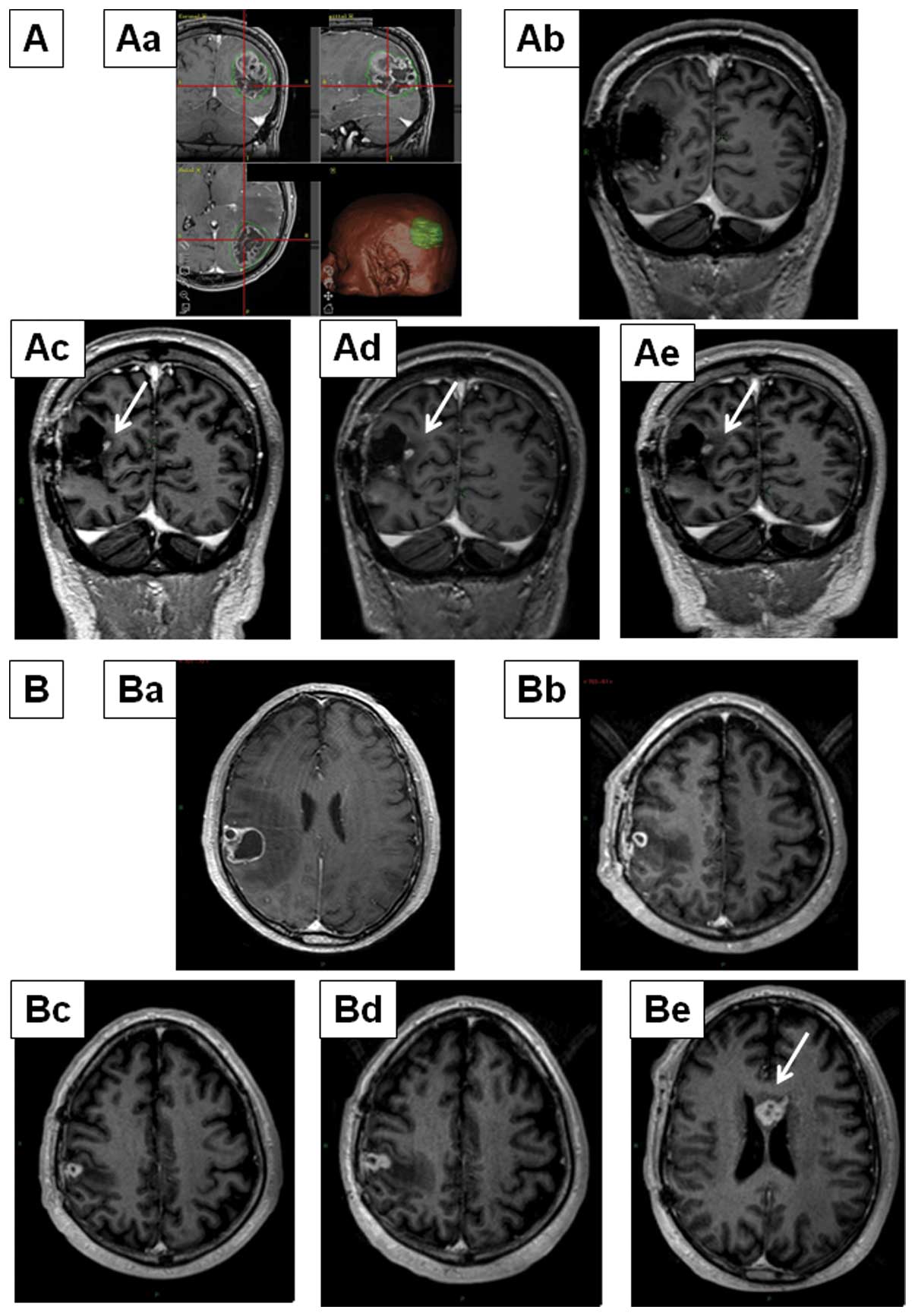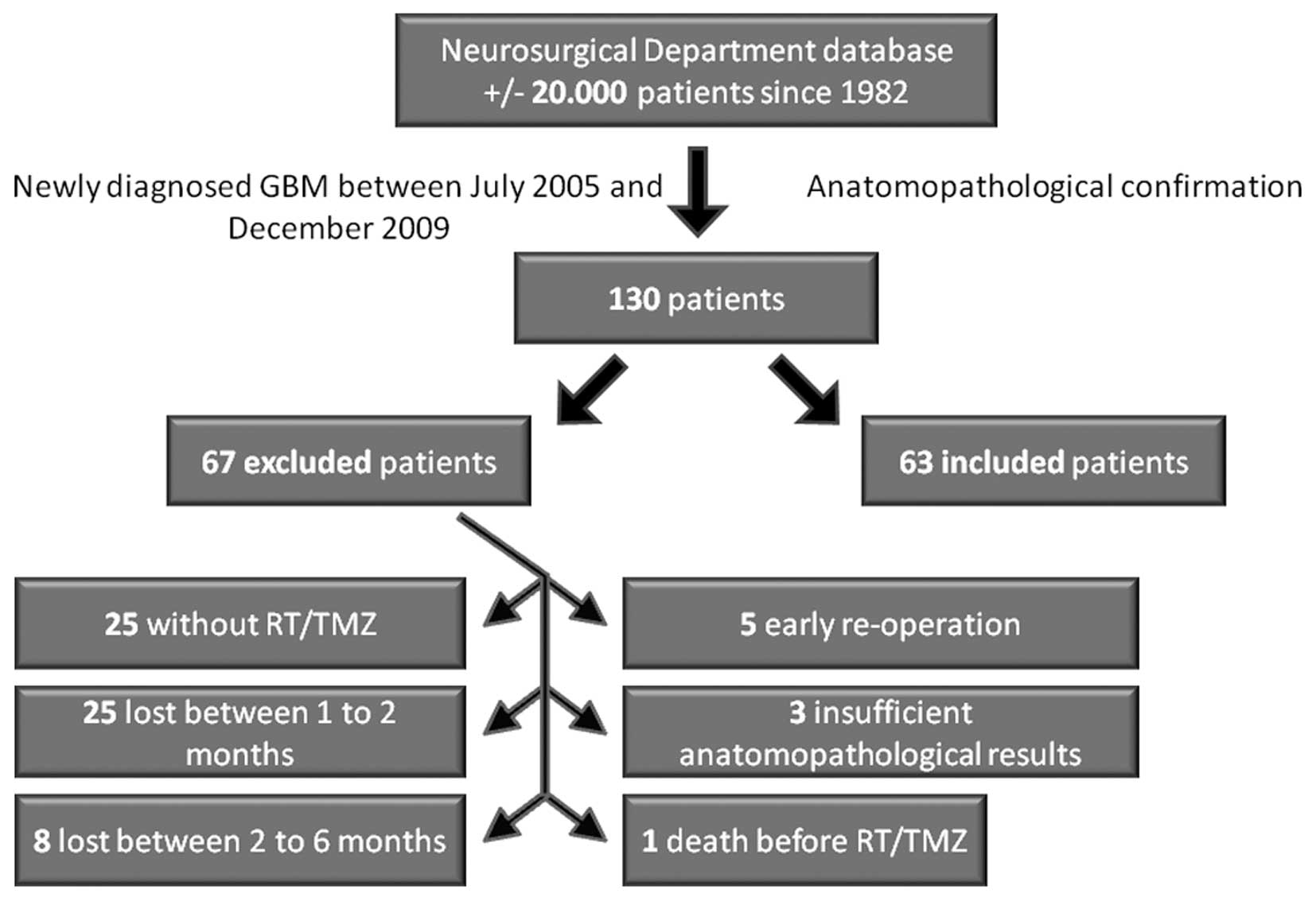|
1
|
Lefranc F, Sadeghi N, Camby I, Metens T,
De Witte O and Kiss R: Present and potential future issues in
glioblastoma treatment. Expert Rev Anticancer Ther. 6:719–732.
2006. View Article : Google Scholar : PubMed/NCBI
|
|
2
|
Lefranc F, Brotchi J and Kiss R: Possible
future issues in the treatment of glioblastomas: special emphasis
on cell migration and the resistance of migrating glioblastoma
cells to apoptosis. J Clin Oncol. 23:2411–2422. 2005. View Article : Google Scholar : PubMed/NCBI
|
|
3
|
Stupp R, Hegi M, Mason W, van den Bent MJ,
Taphoorn MJ, Janzer RC, et al: Effects of radiotherapy with
concomitant and adjuvant temozolomide versus radiotherapy alone on
survival in glioblastoma in a randomised phase III study: 5-year
analysis of the EORTC-NCIC trial. Lancet Oncol. 10:459–466.
2009.
|
|
4
|
Stupp R, Mason WP, van den Bent MJ, Weller
M, Fisher B, Taphoorn MJ, et al: Radiotherapy plus concomitant and
adjuvant temozolomide for glioblastoma. N Engl J Med. 352:987–996.
2005. View Article : Google Scholar : PubMed/NCBI
|
|
5
|
Sanai N and Berger MS: Glioma extent of
resection and its impact on patient outcome. Neurosurgery.
62:753–764. 2008. View Article : Google Scholar : PubMed/NCBI
|
|
6
|
Stummer W, van den Bent MJ and Westphal M:
Cytoreductive surgery of glioblastoma as the key to successful
adjuvant therapies: new arguments in an old discussion. Acta
Neurochir (Wien). 153:1211–1218. 2011. View Article : Google Scholar : PubMed/NCBI
|
|
7
|
Holdhoff M and Grossman SA: Controversies
in the adjuvant therapy of high-grade gliomas. Oncologist.
16:351–358. 2011. View Article : Google Scholar : PubMed/NCBI
|
|
8
|
Brandsma D, Stalpers L, Taal W, Sminia P
and van den Bent MJ: Clinical features, mechanisms, and management
of pseudo-progression in malignant gliomas. Lancet Oncol.
9:453–461. 2008. View Article : Google Scholar
|
|
9
|
Taal W, Brandsma D, de Bruin HG, Bromberg
JE, Swaak-Kragten AT, Smitt PA, et al: Incidence of early
pseudo-progression in a cohort of malignant glioma patients treated
with chemoirradiation with temozolomide. Cancer. 113:405–410. 2008.
View Article : Google Scholar : PubMed/NCBI
|
|
10
|
Topkan E, Topuk S, Oymak E, Parlak C and
Pehlivan B: Pseudo-progression in patients with glioblastoma
multiforme after concurrent radiotherapy and temozolomide. Am J
Clin Oncol. March 10–2011.(Epub ahead of print).
|
|
11
|
Brandes A, Franceschi E, Tosoni A, Blatt
V, Pession A, Tallini G, et al: MGMT promoter methylation statu
scan predict the incidence and outcome of pseudoprogression after
concomitant radiochemotherapy in newly diagnosed glioblastoma
patients. J Clin Oncol. 26:2192–2197. 2008. View Article : Google Scholar
|
|
12
|
Chaskis C, Neyns B, Michotte A, De Ridder
M and Everaert H: Pseudoprogression after radiotherapy with
concurrent temozolomide for high-grade glioma: clinical
observations and working recommendations. Surg Neurol. 72:423–428.
2009. View Article : Google Scholar : PubMed/NCBI
|
|
13
|
Clarke JL, Abrey LE, Karimi S and Lassman
AB: Pseudo-progression (PsPr) after concurrent radiotherapy (RT)
and temozolomide (TMZ) for newly diagnosed glioblastoma multiforme
(GBM). J Clin Oncol. 26(Suppl): abs. 20252008.
|
|
14
|
Gerstner ER, McNamara MB, Norden AD,
Lafrankie D and Wen PY: Effect of adding temozolomide to radiation
therapy on the incidence of pseudo-progression. J Neurooncol.
94:97–101. 2009. View Article : Google Scholar : PubMed/NCBI
|
|
15
|
Jefferies S, Burton K, Jones P and Burnet
N: Interpretation of early imaging after concurrent radiotherapy
and temozolomide for glioblastoma. Clin Oncol. 19(Suppl): abs.
332007.
|
|
16
|
Sanghera P, Perry J, Sahgal A, Symons S,
Aviv R, Morrison M, et al: Pseudoprogression following
chemoradiotherapy for glioblastoma multiforme. Can J Neurol Sci.
37:36–42. 2010. View Article : Google Scholar : PubMed/NCBI
|
|
17
|
De Wit M, De Bruin H, Eijkenboom W,
Sillevis Smitt PA and van den Bent MJ: Immediate post-radiotherapy
changes in malignant glioma can mimic tumor progression. Neurology.
63:535–537. 2004.PubMed/NCBI
|
|
18
|
Hegi ME, Liu L, Herman JG, Stupp R, Wick
W, Weller M, et al: Correlation of O6-methylguanine
methyltransferase (MGMT) promoter methylation with clinical
outcomes in glioblastoma and clinical strategies to modulate MGMT
activity. J Clin Oncol. 26:4189–4199. 2008.PubMed/NCBI
|
|
19
|
Kanzawa T, Germano IM, Komata T, Ito H,
Kondo Y and Kondo S: Role of autophagy in temozolomide-induced
cytotoxicity for malignant glioma cells. Cell Death Differ.
11:448–457. 2004. View Article : Google Scholar : PubMed/NCBI
|
|
20
|
Katayama M, Kawaguchi T, Berger MS and
Pieper RO: DNA damaging agent-induced autophagy produces a
cytoprotective adenosine triphosphate surge in malignant glioma
cells. Cell Death Differ. 14:548–558. 2007. View Article : Google Scholar
|
|
21
|
Roos WP, Batista LF, Naumann SC, Wick W,
Weller M, Menck CF, et al: Apoptosis in malignant glioma cells
triggered by the temozolomide-induced DNA lesion
O6-methylguanine. Oncogene. 26:186–197. 2007. View Article : Google Scholar : PubMed/NCBI
|
|
22
|
Mathieu V, De Neve N, Le Mercier M,
Dewelle J, Gaussin JF, Dehoux M, et al: Combining bevacizumab with
temozolomide increases the antitumor efficacy of temozolomide in a
human glioblastoma orthotopic xenograft model. Neoplasia.
10:1383–1392. 2008.
|
|
23
|
Le Calvé B, Rynkowski M, Le Mercier M,
Bruyère C, Lonez C, Gras T, et al: Long-term in vitro treatment of
human glioblastoma cells with temozolomide increases resistance in
vivo through up-regulation of GLUT transporter and aldo-keto
reductase enzyme AKR1C expression. Neoplasia. 12:727–739.
2010.PubMed/NCBI
|
|
24
|
Le Mercier M, Lefranc F, Mijatovic T,
Debeir O, Haibe-Kains B, Bontempi G, et al: Evidence of galectin-1
involvement in glioma chemoresistance. Toxicol Appl Pharmacol.
229:172–183. 2008.PubMed/NCBI
|
|
25
|
Jensen R: Brain tumor hypoxia:
tumorigenesis, angiogenesis, imaging, pseudoprogression, and as a
therapeutic target. J Neurooncol. 92:317–335. 2009. View Article : Google Scholar : PubMed/NCBI
|
|
26
|
Chamberlain MC, Glantz MJ, Chalmers L, van
Horn A and Sloan AE: Early necrosis following concurrent Temodar
and radiotherapy in patients with glioblastoma. J Neurooncol.
82:81–83. 2007. View Article : Google Scholar : PubMed/NCBI
|
|
27
|
Hu X, Wong KK, Young GS, Guo L and Wong
ST: Support vector machine multiparametric MRI identification of
pseudoprogression from tumor recurrence in patients with resected
glioblastoma. J Magn Reson Imaging. 33:296–305. 2011. View Article : Google Scholar : PubMed/NCBI
|
|
28
|
Yang I and Aghi MK: New advances that
enable identification of glioblastoma recurrence. Nat Rev Clin
Oncol. 6:648–657. 2009. View Article : Google Scholar : PubMed/NCBI
|
|
29
|
Brandsma D and van den Bent MJ:
Pseudoprogression and pseudoresponse in the treatment of gliomas.
Curr Opin Neurol. 22:633–638. 2009. View Article : Google Scholar
|
|
30
|
Kong DS, Kim ST, Kim EH, Lim DH, Kim WS,
Suh YL, et al: Diagnostic dilemma of pseudoprogression in the
treatment of newly diagnosed glioblastomas: The role of assessing
relative cerebral blood flow volume and oxygen-6-methylguanine-DNA
methyltransferase promoter methylation status. AJNR Am J
Neuroradiol. 32:382–387. 2011.
|
|
31
|
Fabi A, Russillo M, Metro G, Vidiri A, Di
Giovanni S and Cognetti F: Pseudoprogression and MGMT status in
glioblastoma patients: implications in clinical practice.
Anticancer Res. 29:2607–2610. 2009.PubMed/NCBI
|
|
32
|
Park CK, Kim J, Yim SY, Lee AR, Han JH,
Kim CY, et al: Usefull of MS-MLPA for detection of MGMT promoter
methylation in the evaluation of pseudoprogression in glioblastoma
patients. Neurooncology. 13:195–202. 2011.PubMed/NCBI
|













